SME Finance Policy Guide
SME Finance Policy Guide
SME Finance Policy Guide
Create successful ePaper yourself
Turn your PDF publications into a flip-book with our unique Google optimized e-Paper software.
10 GLOBAL PARTNERSHIP FOR FINANCIAL INCLUSION<br />
CHAPTER C<br />
<strong>Policy</strong> <strong>Guide</strong> Components<br />
The <strong>Policy</strong> <strong>Guide</strong> covers regulatory and supervisory<br />
frameworks, financial infrastructure, and public interventions.<br />
In addition to the traditional role of ensuring<br />
the stability and efficiency of the overall financial system<br />
at large, regulators can contribute to greater access to<br />
finance by promoting a favorable legal and regulatory<br />
environment. Such an environment establishes the rules<br />
within which all the financial institutions, instruments,<br />
and markets operate in a given country.<br />
This legal and regulatory framework is complemented<br />
by a sound financial infrastructure, which improves<br />
the efficiency and effectiveness of financial intermediation.<br />
A sound payments system and a well-functioning<br />
credit information framework are two essential<br />
elements of a financial infrastructure. They are crucial<br />
to ensure the efficient functioning of financial systems,<br />
even in the presence of an otherwise flawless legal and<br />
regulatory framework.<br />
In addition to designing and enforcing an enabling<br />
regulatory environment and financial infrastructure,<br />
governments and regulators may choose to undertake<br />
more direct market interventions to promote <strong>SME</strong><br />
finance. These can compensate for deficiencies in the<br />
enabling environment in the interim while reforms<br />
are implemented, or address residual market failures,<br />
such as enforcement difficulties, imperfect information,<br />
protection of depositors, and market power. They<br />
include capacity-building for <strong>SME</strong>s to improve their<br />
creditworthiness, credit guarantee schemes, state<br />
banks and funds, and supply chain finance linked to<br />
public procurement and payments.<br />
Strategic Approach<br />
Country-level processes (diagnostics, consultations) are<br />
necessary to assess challenges, to identify policy and<br />
legal responses from this <strong>Policy</strong> <strong>Guide</strong>’s menu of options,<br />
and to determine lead roles, targets, prioritization, and<br />
sequencing. Analysis of the tools and options available,<br />
and the potential impact and cost-effectiveness of each,<br />
should be conducted before selecting and implementing<br />
policy reforms and interventions. 8<br />
Further work is<br />
needed on impact assessment techniques for <strong>SME</strong><br />
<strong>Finance</strong> policies and interventions.<br />
Wider <strong>Policy</strong> <strong>Guide</strong> for <strong>SME</strong> <strong>Finance</strong>:<br />
Financial Inclusion Strategies<br />
Governments and regulators need to take the lead in<br />
supporting improvements in access to finance, displaying<br />
the leadership called for in the G-20 Principles for<br />
Innovative Financial Inclusion. Financial regulators and<br />
governments can add financial inclusion as a goal alongside<br />
prudential regulation and financial system stability,<br />
and develop financial inclusion strategies. The<br />
Consultative Group to Assist the Poor (CGAP) and World<br />
Bank Financial Access survey (2010) of financial regulators<br />
worldwide found that regions that include financial<br />
access in their strategies and mandate their financial<br />
regulators to carry such agendas are also the countries<br />
that reform the most. Regulators with a financial inclusion<br />
strategy are more likely to have more financial<br />
inclusion topics under their purview, and more resources<br />
and staff dedicated to working on these matters.<br />
8 The IFC-commissioned <strong>SME</strong> <strong>Finance</strong> Abatement model offers a quantitative assessment framework for determining the potential<br />
benefits of reforms in reducing barriers to <strong>SME</strong> access to finance. See Annex II.


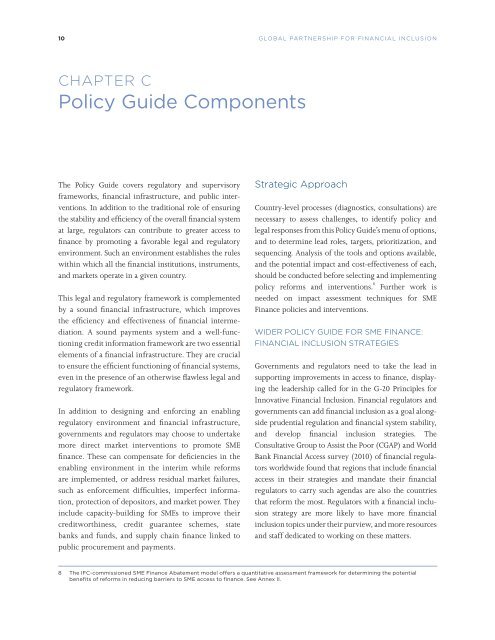
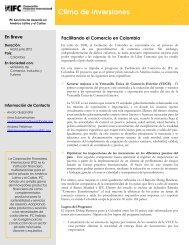
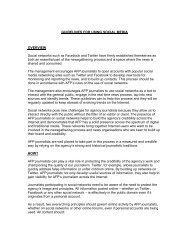
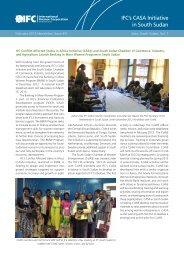

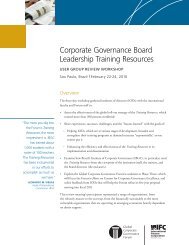




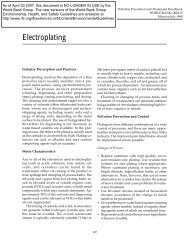

![Print a two-page fact sheet on this project [PDF] - IFC](https://img.yumpu.com/43449799/1/190x245/print-a-two-page-fact-sheet-on-this-project-pdf-ifc.jpg?quality=85)


